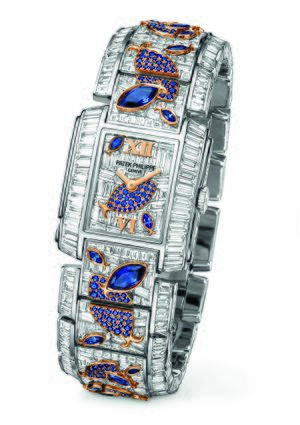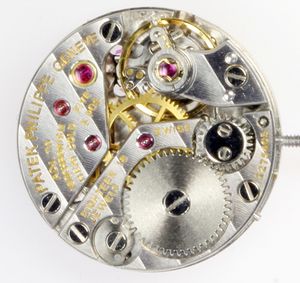Patek Philippe Twenty~4® Haute Joaillerie Ref. 4909/110 "Aquatic Life"
Baselworld 2014
Press Release
Geneva, March 2014
Brilliant in every respect
Since the company was founded in 1839, Patek Philippe has been safeguarding all the artistic skills needed to make the precious inner life of its timepieces visible from the outside, transforming them into the most beautiful and rarest treasures. One stunning example: the remarkable Twenty~4® Haute Joaillerie Ref. 4909/110, a ladies' watch that has its debut at Baselworld 2014. It illustrates that Patek Philippe's ateliers need not shun the comparison with the world's most eminent jewelry houses. Excellence permeates the creativity of the designs, the quality and orchestration of the precious stones, the fixation of the gems in traditional bead and closed settings or gridless pavé and the extremely complex and risky invisible setting technique.
Swimming in diamonds
Altogether 1937 diamonds and sapphires grace the dial, case, bracelet, and clasp of the Twenty~4® Haute Joaillerie Ref. 4909/110 with its poetic "Aquatic Life" motif. All gems are flawless and immaculately cut, the baguette diamonds sparkle in Top Wesselton white, and the fire of the sapphires is intensely blue. With a total weight of approximately 43.73 ct., they form a marine still life that was composed in Patek Philippe's design department and implemented in the manufacture's ateliers according to venerable traditions. It shows blue sapphire fishes of various sizes that swim in an ocean of diamonds.
Closed-set baguette diamonds beam on the gently inclined flanks of the 18K white gold case and bracelet. The diamonds in the case are arranged in subtle fan-shaped pattern, which made it necessary to cut every single one to a shape corresponding to its exact location. The baguette diamonds on the upper side of the bracelet and on the dial are invisibly set. The invisible setting is considered one of the most challenging techniques and from the gemsetter's point of view the most risk-fraught way to set gems. To make sure all stones are seamlessly joined side-by-side and neither parts of the setting nor the white gold of the case and bracelet can shine through between them, the lapidary must grind a narrow groove into the facet on the underside of each diamond baguette. The counterpart of each groove is a delicate gold clip raised out of the bracelet and case which clamps the precious stone and secures it in its place. The positions of the countless clips and of the delicate grooves in the diamonds must correspond to fractions of a millimeter to assure that in the end, the set stones are perfectly adjacent to one another. Each of the blue fishes fashioned from rich-blue sapphires is then applied on this sea of diamonds. The smaller ones are navette-cut sapphire solitaires with a closed rose-gold setting. The larger ones are composed of many small brilliant-cut sapphires held by rose-gold bead settings arranged to depict the contours of the fishes and their speckles. Because fine white diamonds lie beneath these sapphires, the light can easily shine through their blue body color from below, thus amplifying their color intensity and brilliance. Additionally, 855 small brilliant-cut diamonds totaling approximately 1.7 ct. glisten vibrantly between the links of the bracelet.
Mechanical magnificence
The lavishly finished caliber 16-250 is a manually wound mechanical movement that proudly reveals itself through the case back. The two bridges and the balance cock feature round-chamfered and polished edges. Their surfaces are adorned with Geneva striping. Gleaming red bearing jewels provide colorful accents while the balance, the center wheel, and the engravings on the bridges emanate a golden sheen. But above all, it is a mechanical movement crafted to the finest watchmaking standards, one which showcases its functionality: the balance, that vibrates 28,800 times an hour (4 Hz) and with an anchor-shaped lever transmits each semi-oscillation to the escape wheel, which in turn transmits each impulse via the fourth wheel to the third wheel and then to the center and hour wheels that carry the minute and hour hands. The two baton-style hands and the applied Roman numerals at XII and IV in 18K rose gold are typical design features of Patek Philippe's iconic Twenty~4® ladies' watch collection.
"Rare Handcrafts" and Patek Philippe
When Antoine-Norbert de Patek established the Patek Philippe manufacture 175 years ago, he clearly formulated his objective: "to build the world's best and most beautiful watches". This credo explicitly defines a watch as the totality of its mechanical inner life and the facets of its external appearance. It is an aspiration that has remained unchanged and is expressed in writing in the Directives of the Patek Philippe Seal. For this reason, the focus throughout the years was not only on watchmaking artistry. Great emphasis was also placed on the many highly specialized artisanal techniques with which movements and cases were refined. They include different enameling arts such as painting on enamel, cloisonné enamel, champlevé enamel, relief and line engraving, guilloching, as well as the jeweler's and gemsetter's handcrafts. As the demand for lavishly decorated timepieces waned in the 20th century and the community of gifted finissage artists grew smaller, the manufacture still retained their services. This was the case even if the results could not be sold and in the end were added to the private collection of the company's owners, the Stern family. Quite a few of these creations are now highly admired exhibits in the Patek Philippe Museum and so precious that it is justifiable to call them priceless. But perhaps the most important aspect is that, thanks to Patek Philippe's commitment, the last of these artisans were able to pass on their expertise to younger talent, preserving their valuable know-how for current and future generations. These rare handcrafts represent a cultural heritage without which Swiss watchmaking artistry would not have attained its globally unique status.


